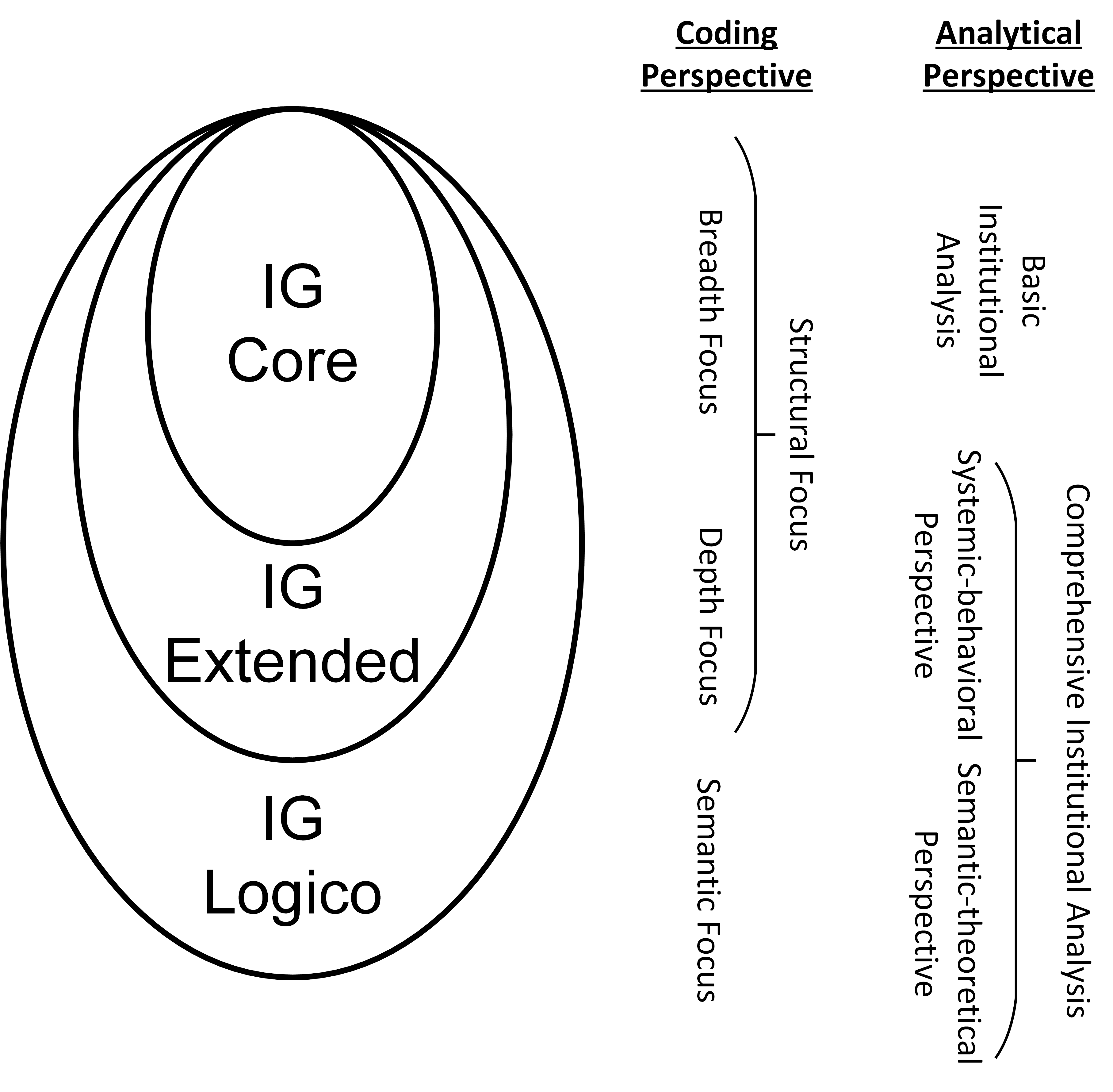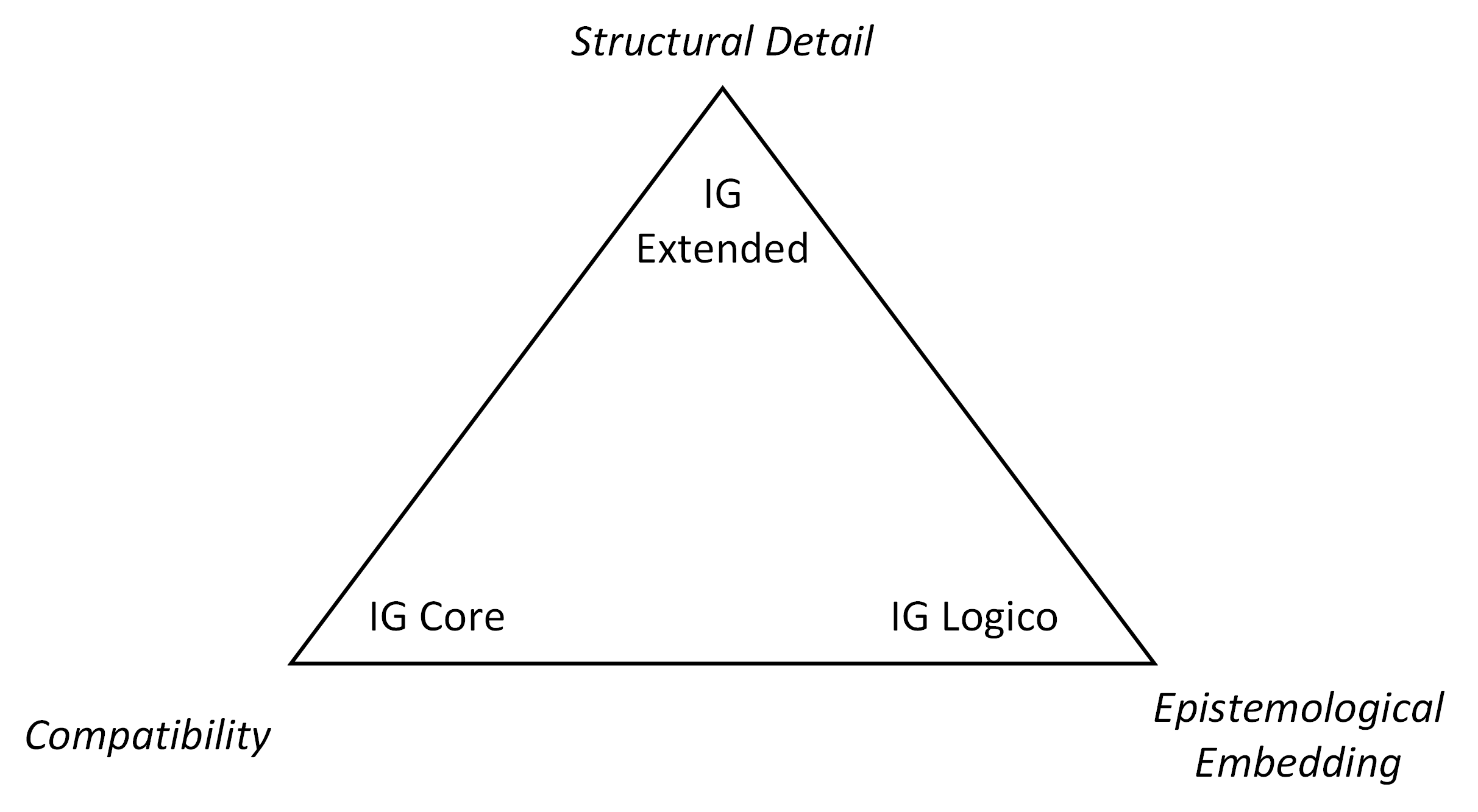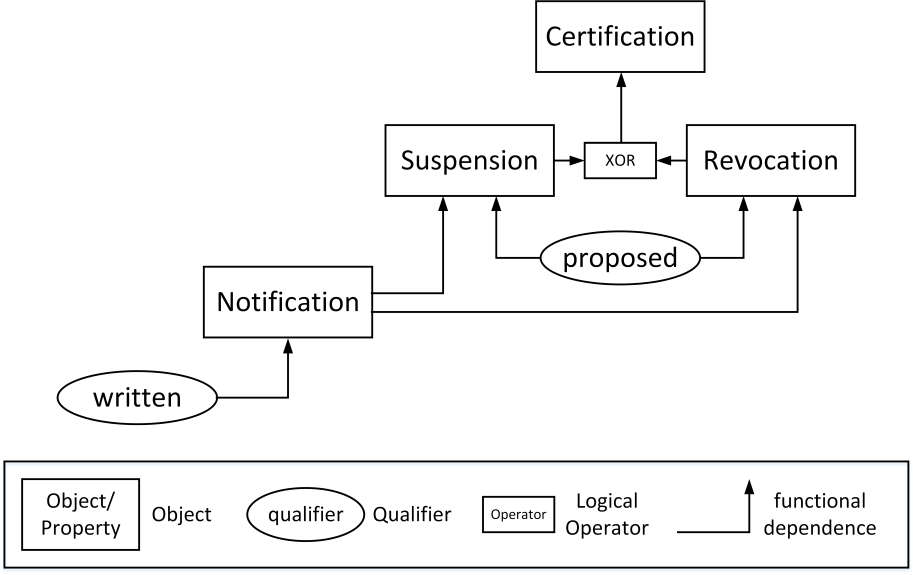Institutional Grammar 2.0 Principles & Features
This page contains an overview of the central features of the Institutional Grammar 2.0 (IG 2.0) in a condensed form for quick reference. This includes the basic principles and motivations, as well as an overview of the different levels of expressiveness, followed by the discussion of specific features organized by level of expressiveness.
Please click on the item of interest to expand the associated details.
Principles
The basic principles that motivate the introduction of the IG 2.0 are listed and explained in this section.
Ontological consistency
Ontological consistency describes the unambiguous characterization of the functional linkage of components in institutional statements with respect to each and/or the institutional setting (for more details, see Section 3.1 of the book). A specific refinement introduced in the IG 2.0 is the distinction between activation conditions and execution constraints as part of a statement specification.
Comprehensive capturing of institutions
Comprehensiveness in the context of the IG describes the ability to parse institutional statements comprehensively without omitting relevant institutional statement (e.g., omitting statements, or information within statements). Specifically the integrated treatment of regulative and constitutive statement forms address this issue, alongside the different forms of nesting that capture institutional information in detail.
Computational tractability
Computational tractability interacts with the objective of ontological consistency by making components and statements as a whole accessible for computational treatment. This includes the well-defined nature of components as well as enabling fine-grained parsing of institutional statements.
Customizability
The IG has found application in diverse domains. The refined IG aims at better accommodating diverse applications of the IG by allowing the analyst to selectively apply or forego features of the IG as part of the parsing process. The aim is to extract information that best corresponds to downstream use using particular analytical techniques (e.g., statistical treatment, behavioral modeling, formal reasoning).
IG 2.0 Features
The specific features of the IG 2.0 are listed by level of expressiveness, ranging from coarse-grained coding via fine-grained structural coding to the augmentation of institutional statements with semantic concepts.
Levels of Expressiveness
Levels of expressiveness reflect the different levels of detail and focus at which institutional statements are encoded to meet different analytical objectives.
IG Core as the basic level aims at capturing institutional information broadly, but comprehensively. Central here is the compatibility to the original Institutional Grammar by Crawford and Ostrom, alongside conceptual refinements that increase the ontological consistency and rigor of the IG. Specific examples include the distinction between activation conditions (conditions that lead to the applicability of a given institutional statements) and execution constraints (qualifications of the activity or function of the institutional statement) as part of the Context components (Conditions in Crawford and Ostrom's version), as well as the introduction of a constitutive syntactic form that enables a comprehensive capturing of institutional information.
IG Extended aims at capturing structural detail by allowing fine-grained parsing on component level (i.e., parsing of institutional information within individual components), as well as extraction of richer conceptual structures embedded in institutional statements (e.g., conceptual relationships between entities in component property). This further includes the richer contextualization of selected components based on annotations of Context.
IG Logico, as the highest level of expressiveness, focuses on the semantic aspects of the institutional information, and specifically the epistemological embedding of the statement parsing in the theory and/or frameworks of interest. This includes the augmentation of encoded information with semantic annotations derived or linked to particular theories, or drawn from selected taxonomies maintained as part of the IG 2.0 (e.g., role annotations, governance functions of actors/actions). IG Logico further introduces a formal syntactic and semantic treatment of institutional statements, including the ability to transform institutional statements based on their structural properties.
In IG 2.0, a central assumption is the incremental encoding of institutional information at the different levels and their features (ensuring that features on higher levels can draw on features encoded on lower levels) as visualized in the following.

However, analysts are free to selectively draw on features from specific or across levels that best correspond to their analytical needs or objectives as part of their coding, with the main priorities for the different levels highlighted in the figure below.

IG Core
The central features introduced under IG Core include:
Regulative and Constitutive Statements
The IG supports the notion of regulative and constitutive statements.
Regulative statements include expressions that regulative of particular actors' behavior in terms of permissions (e.g., may) or associated duty (e.g., obligations or prohibitions), and in the IG, follow a principle structure that includes Attributes, Deontic, Aim, Object variants (direct and indirect object), and Context variants (activation conditions and execution constraints). Regulative statements can further describe consequences for the non-fulfillment of specified statements.
Example: A(Citizens) D(must) I(submit) Bdir(tax returns) Bind(at the end of the following financial year).
This statement explicitly signal obligations associated with a particular actor.
Constitutive statements describe features of an institutional setting, e.g., by defining or introducing entities into the institutional setting, which can include actors, aims, venues, roles, objects and artifacts relevant in a given institutional setting. Central components include the Constituted Entity, Modal, Constitutive Function, Constituting Properties, Context variants (activation conditions and execution constraints). Constitutive statements can further describe consequences for the non-fulfillment of such statements. In contrast to regulative statements, such consequences are often existential in kind.
Example: E(Voters) F(are) P(citizens) P,p(aged 18 and older).
This statement defines what voters are. Specific permissions and duty can be specified by corresponding regulative statements.
Statement-level Nesting
Central to the IG 2.0 is the introduction of nested institutional statements. The concepts builds on two observations, firstly that consequences in institutional statements have the structure of institutional statements (or states) themselves, and can thus be expressed using the same the syntactic form as applied for the leading statement. Consequently, institutional statements are divided into a part that is monitored (reflecting the monitored statement), and the second consequential part (reflecting the consequential statement) that captures the consequences for violating the monitored statement. This form of nesting is referred to as vertical nesting.
Example: A(Individuals) D(must [NOT]) I(violate) Bdir(public order), or else O{A(enforcement officials) D(must) I(intervene)}.
The second observation refers to the common combination of terms in natural language, such as the combination of selected components (e.g., multiple actors and actions, such as Individuals may not enter or leave dwellings during curfew.) in a single statement. Such statements can be conceptually decomposed into logically-combined atomic institutional statements to capture the institutional content in detail and with semantic precision. This form of nesting is referred to as horizontal nesting, since the evaluation of one statement (unlike in the vertical case) is in principle not conditional on the other.
Example: A(Individuals) D(may [NOT]) I((enter [AND] leave)) Bdir(dwellings) Cac(during curfew)., which is conceptually equivalent to
{A(Individuals) D(may [NOT]) I(enter) Bdir(dwellings) Cac(during curfew).} [AND] {A(Individuals) D(may [NOT]) I(leave) Bdir(dwellings) Cac(during curfew).}
Note that this particular example reveals the ambiguous use of or in natural language; logically, the statement implies the prohibition to neither enter nor leave. The purpose of the logical operators is to make such linkages explicit.
IG Extended
The central features introduced under IG Extended include:
Component-level Nesting
Component-level nesting extends the concept of statement-level nesting by allowing the substitution of individual components with institutional state(ments). This way it is possible to explicitly parse the structure of activation conditions, which often contain institutional state information expressed in terms of the AIC or EFC pattern. This principle extends to various other components, including Attributes, Object variants, Context variants, Constituted Entities, Constituting Properties, as well as all Properties associated with selected components (e.g., Attributes Properties).
Example: A(Student) D(must) I(submit) Bdir(assignment) Cex(by the end of the term), Cac{unless [NOT] A(coordinator) I(has specified) a Bdir,p(different) Bdir(due date) Cex(in the course description)}.
Object-Property/Concept Hierarchy
A central feature to capture concept structures embedded within institutional statements is to be able to recognize the quality of the relationships of concepts, including the detection of functional dependencies (e.g., a suspension of certification, where the suspension necessarily depends on the existence of the certification in the first place) and potential logical relationships between those concepts. This feature is useful if the analyst seeks to extract a concept hierarchy, e.g., for the construction of ontologies, as part of the analysis process. The following figure exemplifies this for a given scenario describing a certification that can selectively be suspended, revoked based on a written notification. A richer discussion is offered as part of Section 5.1.4 of the book, as well as the IG 2.0 Codebook.

Property Typology
The Property Typology offers a systematic qualification of properties as either quantitative or qualitative in nature (alongside further sub categories) in order to differentiate descriptors that are central for the evaluation of the fulfillment of a provision (e.g., *all* *accredited* members shall vote, where all is a descriptor of quantitative kind, whereas accredited merely captures the quality associated with the concept members). The principles and the motivation of this feature are further discussed in Section 5.1.5 of the book.
Context Taxonomy
The Context Taxonomy builds on Crawford and Ostrom's original conceptual characterization of the Conditions component (e.g., temporal, spatial and procedural aspects) and expands this categorization into a richer taxonomic structure that captures diverse types of context, including method, event and domanial categories, amongst others. Details are provided in the IG 2.0 Codebook.
IG Logico
The central features introduced under IG Logico include:
Semantic Annotations
IG Logico aims at developing an epistemological linkage between the domain of interest and the encoded institutional information. Central here is the ability to annotate encoded information using semantic annotations that capture functional role (Institutional Functions) or signal that the component values convey with respect to the domain or through the applied analytical lens. Referencing an example of such institutional function, analyzing an institutional setting with respect to compliance behavior not submitting the tax return on time reflects a violation (whereas submission on time reflects the institutional function of signaling compliance). IG 2.0 provides a set of predefined taxonomies prepared for the annotations of selected components (e.g., roles, metatypes of referenced concepts, as well as institutional functions in the context of compliance assessment), but further allows for the introduction of classifications drawn from the domain of the analyst. More details can found in Section 6.1.2 onwards in the book, as well as the IG 2.0 Codebook.
Statement Transformations
With the encoding at higher levels of expressiveness (IG Extended or Logico), institutional statements can in principle be transformed algorithmically, e.g., to reflect policy from specific actors' perspectives, establish a uniform structural representation to facilitate downstream analysis or comparative studies, or extrapolation of multiple involved actors' perspectives tacitly captured in institutional statements for richer behavioral models or assessment of biases captured in policy. See Section 6.1.4 of the book for details on transformation rules and Section 8.3 for illustrative applications.